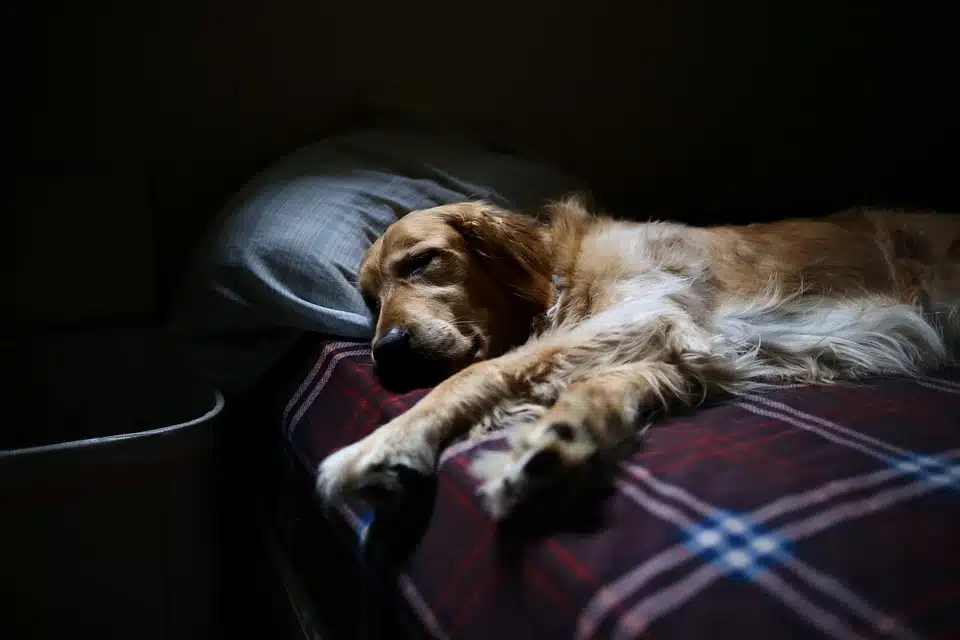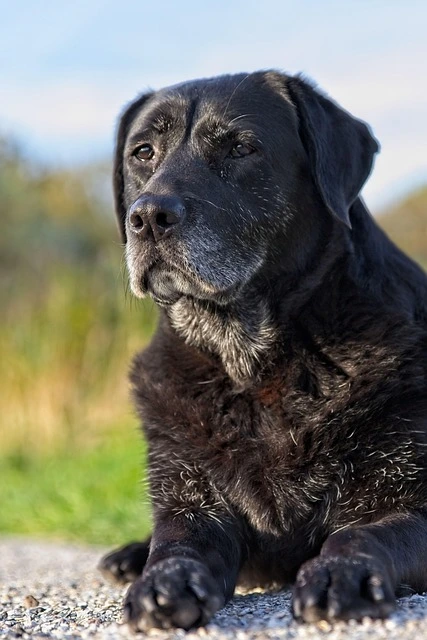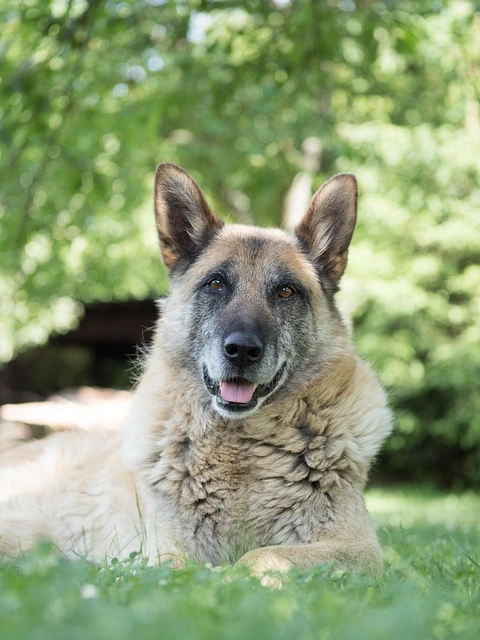It’s 2 AM and you’re jolted awake by that familiar sound – the rhythmic panting of your furry friend in the darkness. Your dog seems restless, moving from spot to spot, tongue lolling as they pant heavily despite the comfortable room temperature. Dog panting at night can disrupt both your sleep and signal something might be off with your four-legged companion.

Table of Contents
Quick Answer
Dog panting at night typically indicates overheating, anxiety, or pain that disturbs your pet’s sleep. While occasional panting is normal, persistent nighttime panting often signals discomfort requiring environmental adjustments or veterinary attention.
TL;DR: Nighttime dog panting usually stems from heat, anxiety, or pain. Create a cooler sleeping area, establish calming routines, and consult your vet if panting is excessive or accompanied by other symptoms.
15-Second Assessment Checklist
- Room temperature below 70°F? ☐
- Fresh water available? ☐
- Appropriate bed type (cooling/supportive)? ☐
- Last exercise >2 hours before bedtime? ☐
- Medication timing optimized for sleep? ☐
Why It Matters
When your dog pants excessively at night, it’s more than just an annoying sound keeping you awake. Prolonged panting can indicate your dog is experiencing:
- Physical discomfort or pain that worsens when they try to relax
- Respiratory distress that can lead to oxygen deprivation
- Anxiety that prevents proper rest and recovery
- Overheating, which can progress to heat stroke in severe cases
- Cognitive issues in senior dogs that disrupt their sleep-wake cycle
Left unaddressed, these issues can lead to chronic sleep deprivation for both you and your pet, weakening your dog’s immune system and potentially masking symptoms of serious underlying conditions. A well-rested dog is a healthier, happier companion, which makes solving nighttime panting worth the effort.
Understanding Dog Panting: The Basics
Unlike humans who cool down primarily through sweating, dogs have limited sweat glands (mainly in their paw pads). Panting is their primary cooling mechanism. When a dog pants, they:
- Increase air flow over their tongue, throat, and upper respiratory tract
- Evaporate moisture from these surfaces
- Release heat from their body
- Lower their internal temperature
Normal panting appears relaxed, with a regular rhythm and moderate tongue extension. In contrast, problematic panting often involves:
- Heavier, more labored breathing
- Unusual sounds (wheezing, rattling, or choking)
- Exaggerated tongue extension or unusual mouth positioning
- Changes in gum color (pale, bluish, or very bright red)
Last summer, my Labrador Max started panting heavily each night around midnight. I initially blamed the weather, but after noticing he only did this indoors, not during our evening walks, I realized our bedroom was trapping heat. The solution was surprisingly simple – a small fan pointed away from him created just enough air circulation to solve the problem.
The American Kennel Club notes that different breeds have varying heat tolerances, with brachycephalic breeds (like Bulldogs and Pugs) being particularly susceptible to overheating due to their shortened airways, sometimes requiring additional cooling measures even in moderate temperatures.
Common Causes of Nighttime Panting
1. Environmental Heat
Even moderate room temperatures can feel warm to certain breeds, especially those with thick coats or brachycephalic (flat-faced) features. Your home might be retaining heat in walls and flooring that releases slowly throughout the night, creating a warmer sleeping environment than you perceive.
2. Anxiety or Stress
Dogs are creatures of routine, and disruptions can trigger anxiety-based panting. Common triggers include:
- Changes in household routine or composition
- Unfamiliar sounds or scents
- Separation anxiety when sleeping away from you
- Previous traumatic experiences that surface during quiet nighttime hours
3. Pain or Discomfort
Dogs often mask pain during active daytime hours but struggle to suppress it when trying to relax at night. Common sources include:
- Arthritis or joint pain that worsens when lying down
- Dental issues
- Digestive discomfort
- Recent injuries that seem minor during the day
4. Medical Conditions
Several health issues can cause nighttime panting:
- Heart disease
- Respiratory conditions
- Cushing’s disease
- Laryngeal paralysis
- Medication side effects (particularly steroids)
5. Age-Related Changes
Senior dogs commonly experience cognitive dysfunction syndrome (similar to dementia), which can disrupt their normal sleep patterns and cause nighttime restlessness and panting.
6. Recent Exercise or Excitement
Evening play sessions or late walks can elevate your dog’s body temperature for hours afterward, leading to cooling-related panting when they should be settling down.
7. Breed Predispositions
Some breeds are simply more prone to panting due to their physical structure:
- Brachycephalic breeds (Bulldogs, Pugs, Boston Terriers)
- Heavy-coated northern breeds (Huskies, Malamutes)
- Large, deep-chested breeds (Great Danes, Saint Bernards)
According to the American Veterinary Medical Association, respiratory efficiency varies significantly between breeds, with some dogs requiring more frequent panting to achieve the same cooling effect as others, especially in multi-dog households where ambient temperature is set for human comfort.
Tools & Products for Nighttime Comfort
[HEAT] Cooling Pet Mat for Hot Sleepers
This pressure-activated cooling mat provides instant relief for dogs who run hot at night. It requires no electricity, refrigeration, or water filling – the gel interior activates through your dog’s body weight to draw away heat. Perfect for dogs who seek out tile floors or cold surfaces, it offers 3-4 hours of continuous cooling before needing a short “reset” period. The non-toxic fill makes it safe even for chewers (though supervise initially), and the wipe-clean surface handles drool and paw prints easily. Ideal for medium to large breeds who struggle with nighttime overheating. One limitation: very anxious chewers might damage the outer material, so introduce gradually. The Green Pet Shop Cooling Mat
[HEAT] Elevated Dog Bed for Airflow
The Bedsure Elevated Dog Bed lifts your pup about 7 inches off the ground, creating constant airflow underneath to help them stay cool while they sleep. Its breathable Teslin mesh fabric prevents hot spots and resists trapping heat, while the sturdy steel frame supports even large breeds. The fabric surface is detachable and easy to clean, making it practical for daily use indoors or outdoors. Best for medium to extra-large dogs who pant from overheating, especially in homes without strong air conditioning. The only limitation is that cold-natured dogs might find it less cozy in winter, so consider pairing it with a light blanket during colder months. Bedsure Outdoor Elevated Dog Bed.
[ANXIETY] Calming Diffuser for Anxiety-Based Panting
This plug-in diffuser releases a synthetic version of the comforting pheromone nursing mother dogs produce to calm their puppies. Unlike scented products that mask anxiety, this actually helps reduce the stress response at a neurological level. Each diffuser covers approximately 700 square feet, making it perfect for bedrooms or small living areas where your dog sleeps. Most effective for dogs whose nighttime panting stems from anxiety, separation issues, or noise sensitivity. One limitation is that it works gradually over 1-2 weeks rather than providing instant results, so start using it before stressful events when possible. Adaptil Calming Diffuser for Dogs .
[PAIN] Orthopedic Bed for Pain-Related Panting
This memory foam bed provides crucial support for older dogs or those with joint pain who pant due to discomfort when lying down. The egg-crate orthopedic foam distributes weight evenly to eliminate pressure points, while the bolstered sides offer head support and a sense of security. The waterproof inner liner protects against accidents, and the entire cover zips off for easy washing. Ideal for senior dogs, those with arthritis, or recent surgical patients whose nighttime panting stems from positional discomfort. Its only limitation is that it retains some body heat, so it’s not the best choice for dogs who primarily pant from overheating. FurHaven Orthopedic Dog Bed .
Step-by-Step Solutions for Dog Panting at Night
For Heat-Related Panting:
- Optimize the sleeping environment Create a cooling zone by placing a fan nearby (not blowing directly on your dog), lowering the room temperature 2-3 degrees at night, or moving their bed away from heat-retaining walls.
- Provide appropriate bedding Replace insulating beds with cooling mats or elevated cots that promote airflow. For dogs who prefer softer surfaces, place a thin cotton sheet over a cooling mat.
- Pre-cool your dog before bedtime Schedule walks during cooler hours, offer fresh water throughout the evening, and consider a gentle wipe-down with a slightly damp towel (not soaking) before bed.
- Create cooling stations Place a shallow pan of water where your dog can dip their paws if needed, as paw pads are a primary cooling zone. Alternatively, freeze a towel-wrapped water bottle they can lie against.
- Maintain proper hydration Ensure clean water is available throughout the night, possibly using a recirculating water fountain to encourage drinking.
For Anxiety-Related Panting:
- Establish a consistent bedtime routine Create predictability with a 15-20 minute wind-down routine including quiet time, gentle interaction, and perhaps a brief training session with rewards.
- Provide appropriate security items Offer an article of your clothing with your scent, a specific “nighttime only” toy, or a properly fitted anxiety wrap.
- Create a safe sleep space Ensure their sleeping area is semi-enclosed and away from windows where outside movement might trigger alertness. White noise machines can mask startling sounds.
- Consider natural calming aids Try pheromone diffusers, calming music specifically designed for dogs, or vet-approved supplements containing ingredients like L-theanine or tryptophan.
- Practice daytime confidence building Gradually increase short periods of independent relaxation during the day to build confidence for nighttime separation.
For Pain-Related Panting:
- Provide appropriate supportive bedding Invest in orthopedic bedding that distributes weight evenly and eliminates pressure points on sensitive joints or areas.
- Create easy access to sleep areas Ensure beds are easily accessible without jumping or climbing, possibly using ramps or steps for elevated sleeping areas.
- Adjust medication timing with veterinary guidance If your dog is on pain medications, work with your vet to optimize the dosing schedule so peak effectiveness coincides with sleep hours.
- Apply gentle warmth for arthritic pain For joint pain specifically, a pet-safe heating pad (on low setting) placed under half of the bed can provide relief. Always ensure your dog can move away from the heat if desired.
- Consider gentle evening massage Learn basic massage techniques from your veterinarian to help relax tense muscles before bedtime.
Cooling Options Compared: Gel vs. Water vs. Cot Beds
Gel Cooling Mats
- Pros: No electricity needed, activates automatically, portable, moderately durable
- Cons: Cooling effect lasts 3-4 hours before needing “reset” time, may be punctured by determined chewers, slippery surface for some dogs
Water-Filled Cooling Mats
- Pros: Customizable temperature (based on water temperature), longer-lasting cooling effect, often more affordable
- Cons: Risk of leaks, heavier than alternatives, requires filling/maintenance, less portable
Elevated Cot Beds
- Pros: Constant airflow without “recharging” needed, highly durable, good for dogs who chew, washable covers
- Cons: Less intense cooling than active cooling products, less cushioning for arthritic dogs, some dogs dislike the suspended feeling
Breed and Size Cooling Guide
- Small Breeds (under 20 lbs – Chihuahuas, Yorkies, Miniature Dachshunds): Heat-sensitive despite small size, benefit from smaller cooling mats, monitor for rapid temperature changes.
- Medium Breeds (20-50 lbs – Beagles, Cocker Spaniels, Bulldogs): Brachycephalic types need more cooling assistance, benefit from combination of elevated beds and cooling mats.
- Large Breeds (50-90 lbs – Labradors, Pit Bulls, German Shepherds): Higher body mass retains heat, need larger cooling surface areas, elevated beds provide crucial airflow.
- Extra Large Breeds (90+ lbs – Great Danes, Mastiffs, Saint Bernards): Significant heat generation, benefit from multiple cooling options, often need cooling surfaces in several household locations.
Common Mistakes (and Fixes)
- Providing too much bedding. The fix: Remove insulating padding during warmer months; one thin layer on a hard floor is often sufficient.
- Overreacting to normal panting. The fix: Time the duration—normal post-activity panting should resolve within 10-20 minutes.
- Keeping the home too warm at night. The fix: Lower nighttime temperature 2-3 degrees below your daytime setting.
- Exercising too close to bedtime. The fix: Schedule vigorous exercise at least 2-3 hours before bedtime to allow complete cool-down.
- Missing anxiety triggers. The fix: Keep a log of when panting occurs to identify patterns related to external events.
- Placing beds near heat sources. The fix: Move sleeping areas away from heating vents, electronics, or sun-exposed windows.
- Misinterpreting thirst as panting. The fix: Ensure fresh water is always available, especially right before bedtime.
Troubleshooting Persistent Panting
- If your dog pants only in certain rooms, then evaluate the room temperature variation with a digital thermometer; some spaces can be 5+ degrees warmer than others.
- If panting starts after midnight, then check if your home’s temperature regulation system reduces cooling during sleeping hours.
- If panting increases when lying down, then suspect pain or respiratory issues; try offering varied bedding options and consult your veterinarian.
- If panting occurs alongside restlessness, then implement a more structured bedtime routine and consider anxiety-reduction techniques.
- If senior dogs develop new panting habits, then discuss cognitive dysfunction with your veterinarian; medication and environmental management can help.
- If panting improves with position changes, then your dog may have developing joint pain; try an orthopedic bed and consult your veterinarian about early intervention.
- If panting happens despite a cool environment, then record a video to show your veterinarian as this could indicate a developing medical condition.
When to See a Professional
Contact your veterinarian promptly if your dog’s nighttime panting:
- Is accompanied by unusual breathing sounds (wheezing, honking, or gasping)
- Occurs with blue-tinged or very pale gums
- Happens alongside unusual lethargy or reluctance to move
- Persists for more than 20-30 minutes without obvious cause
- Starts suddenly in a dog with no history of nighttime panting
- Appears with other symptoms like coughing, excessive drinking, or difficulty rising
- Doesn’t improve after trying the environmental modifications described above
According to the American Veterinary Medical Association, respiratory distress should always be treated as an emergency, particularly in brachycephalic breeds who already have compromised breathing capacity.
Frequently Asked Questions
Is all nighttime panting abnormal?
No. Brief panting after changing positions, following evening exercise, or during warmer weather is normal. Concern arises when panting is excessive, persistent, or accompanied by other symptoms.
Could my dog’s weight be causing nighttime panting?
Absolutely. Overweight dogs are more prone to overheating, joint pain, and respiratory issues—all of which can cause nighttime panting. Even modest weight loss (5-10%) can significantly improve comfort. The American Kennel Club offers excellent resources on healthy weight management for different breeds.
Can anxiety medication help with nighttime panting?
For dogs whose panting stems primarily from anxiety, your veterinarian might recommend behavioral medication. These aren’t sedatives, but rather help balance brain chemistry to reduce the physiological stress response, often allowing natural sleep patterns to return.
Why does my older dog pant more at night now?
Senior dogs commonly develop cognitive dysfunction syndrome (canine dementia), which can disrupt normal sleep-wake cycles and cause nighttime confusion, anxiety, and panting. Other age-related factors include decreased temperature regulation efficiency and increased joint pain.
Could my dog’s medication be causing the panting?
Yes. Several medications, particularly corticosteroids like prednisone, can increase panting as a side effect. Never discontinue prescribed medication, but do discuss the timing of doses with your veterinarian to minimize nighttime effects.
Is nighttime panting an emergency?
It depends on accompanying symptoms. Excessive panting with blue/pale gums, difficulty breathing, collapse, or extreme lethargy requires immediate emergency care. Mild to moderate panting without other symptoms usually isn’t urgent but should be monitored and discussed with your vet.
Can I use human cooling products for my dog?
Most human cooling products aren’t designed for fur-covered bodies and may contain ingredients unsafe for dogs if chewed. Stick with pet-specific cooling products that account for different cooling needs and safety considerations.
Conclusion
Nighttime panting is your dog’s way of communicating discomfort, whether from heat, anxiety, pain, or medical issues. By observing patterns, creating a cooler and more comfortable sleeping environment, and addressing underlying causes, you can help your four-legged friend rest peacefully through the night. Remember that new or dramatically increased panting always warrants a conversation with your veterinarian, especially when accompanied by other changes in behavior or physical symptoms. With thoughtful management and appropriate veterinary care when needed, both you and your dog can enjoy the restful sleep you deserve. Try implementing one or two suggestions from this guide tonight, and adjust based on your dog’s response. Sweet dreams await!

